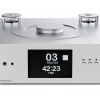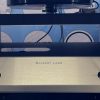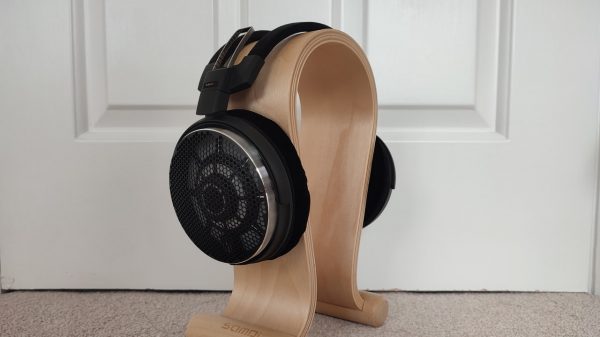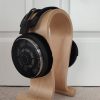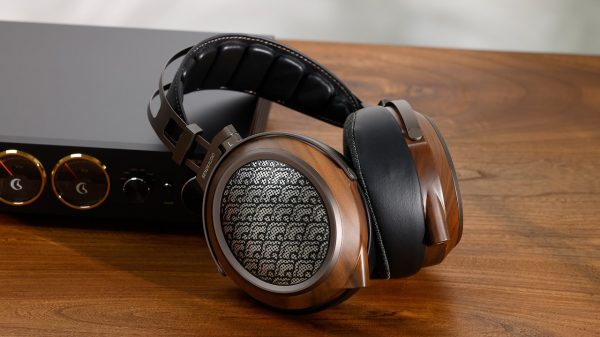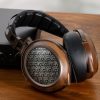Sitting alone listening to music in the dark the other night as the winds began to howl across the Shore and blanket sections of the Garden State with debris, I was lifted out of my trance when a transformer exploded in our neighborhood. The winds were not kind to trees, fencing, or telephone poles and it didn’t take long before all went dark. Having survived more than a few major disasters here over the past decade, I had already turned most things off for the night knowing the consequences if I did not. The Audeze LCD-1 sat on the couch next to me.
As the winds begin to howl outside, I added a dozen albums from Foy Vance, Stereolab, Nina Simone, Stanley Turrentine, Hildur Guðnadóttir, and Max Richter to my Qobuz offline library for playback through my MacBook Pro.
Audeze LCD-1 headphones and the brand new, Clarus CODA USB DAC/Headphone amplifier had been burning in all week connected to my iMac/Schiit Magni+ system in my home office before I decided to schlep them upstairs for the late-night listening on the sofa.
With the wife and kids hunkered down for the night with their flashlights (the power would return a few hours later), I pulled back the curtains to watch the wind-swept debris pile up on a broken piece of fencing that had toppled over from the force of the onshore winds.
I use my MacBook Pro a lot for music listening; prior to the day job going remote due to COVID-19 restrictions here in New Jersey, I would take my AudioQuest DragonFly Cobalt USB DAC and a pair of HiFiMan Sundara headphones to work with me on a daily basis. With some degree of isolation from the rest of the office, I was able to work and listen for a few hours each day before working with our teams in China, Poland, and Germany on group projects.
I travel enough to notice that I’m not alone in this practice. Headphones are not only the gateway drug for some into our little hobby – they are the drug of choice for millions of people.
Many of them will never invest in a high-end two-channel system and there is nothing wrong with that.
Audiophiles who judge them harshly are missing the point.

One brand that understands that there has been a quantum shift in listening habits is Audeze. Not only have they continued to develop state-of-the-art products, but they have focused heavily on the gaming segment and that was clearly the way to go considering how many millions of people play daily. I’ve raised 3 avid gamers, so I know the drill. So does my bank account.
I remember trying some of the earliest Audeze models and loving the sonics but really having an issue with the industrial design and weight of the products; I’m a large guy (6’3”) with a big head and I couldn’t deal with the sensation of wearing a suitcase on my head for more than 10 minutes. Audeze has made huge strides in that department but it made me rethink the idea of dropping $3,000 on a pair of headphones unless they were very lightweight – and super comfortable to wear for much longer stretches of time.
The LCD-1 are nowhere near $3,000; their $399 price tag makes them very competitive in the open-back planar magnetic category.
They are also very easy to drive and the most comfortable pair of headphones from the brand that I’ve ever worn.

Back to the Future
The $300 Clarus CODA is a bold move by the brand that is primarily focused on high-end cables and power conditioning solutions.
I’ll let that settle for a second before I continue.
Yes – AudioQuest invented the portable DAC/Headphone amplifier category with their DragonFly Series ($99 to $299) which has dominated the segment since its inception.
I own 3 different DragonFly variants and have recommended them to readers, friends, and family for the past 5 years. AudioQuest has kept its foot on the gas with the Cobalt and I’m sure the next generation product from the creative mind of Gordon Rankin will be even better.
Dongle DACs which connect to your smart phone, or tablet are a new category that is gaining traction as we head into 2021 but the CODA is one of the first really competitive challenges to the DragonFly that I’ve seen so far.
The CODA differs from the Cobalt in a few areas; the ESS Sabre DAC can natively decode up to 32-bit/384kHz PCM, and there are surface mounted 64-step volume buttons on the device itself. If you wish to play DSD files, you need to convert them to a DoP file using JRiver or something similar before sending to the CODA.
The CODA also offers three different roll-off filter settings and support for MQA – Tidal Masters can be decoded just fine.
I have less than 20 hours of listening time on either component but I’m liking what I’m hearing so far from the overall combination.
The LCD-1 are very spacious sounding, and detail retrieval is excellent.
Midrange punch is definitely not its strength so far; especially compared to headphones like the Meze Audio 99 Classics, HiFiMan Sundara, and HiFiMan Deva.
The CODA has excellent transparency and detail and I’m definitely going to be trying it with the other aforementioned headphones to see if it’s the DAC or LCD-1 that lacks some dynamic punch.
Continue reading part 2 of this review →
For more information:
Where to buy:
- Buy the Audeze LCD-1 for $399 at Amazon or Audeze.com
- Check the dealer locator for Clarus CODA






